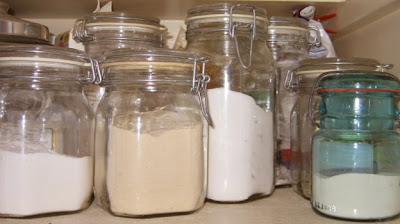Mixed-up Flours
The first time I tried to make scones with a GF flour mix the dough smelled like salty beans. I looked at the ingredients on the store-bought package only to find - sure enough - garbanzo bean flour. After trying a few other pre-made mixes with similarly disastrous results, I decided I could do better on my own. Over the last year or two I've been experimenting with making my own gluten-free flour mixes. While I'm not quite ready to share this secret concoction with the world, I do want share what I've learned about the properties of some basic gluten-free flours. Brown rice flour: It gives your product lots of texture and flavor. However, it is not pliable enough to be used by itself in most recipes, and it produces a dense, heavy, whole-grain feel.
Brown rice flour: It gives your product lots of texture and flavor. However, it is not pliable enough to be used by itself in most recipes, and it produces a dense, heavy, whole-grain feel.
White rice flour: This gives you a somewhat lighter and more pliable dough than brown rice flour, but without the benefit of the flavor of the whole grain. It is made from raw white rice.

Glutinous rice flour (or sticky rice flour): This flour does not contain gluten! The term is only meant to convey the gluey texture the flour has when wet. It is to be distinguished from white rice flour in that it is made from cooked white rice.
Potato flour and potato starch: This is the one flour that changed my mix the most. Bob's Red Mill says it best when they say it "lends a moist crumb." It also improves the elasticity of your dough quite a bit.
Tapioca starch: This flour is instrumental in getting your product to brown when cooked. You don't need to use a lot to reap its benefits, but if you use too much the dough will be gluey and dense.
Sorghum: This flour improved the taste of my flour mixes immensely. It has a sweet, nutty flavor. Use too much, however, and the dough will be wet and sticky.
Xanthan gum: This is not a flour but a gluten substitute. It is absolutely necessary for making your dough elastic.
These are the basic flours you will need to make all your gluten-free fantasies come true. Stay tuned - next week you can get my take on flours for more specialized purposes.
 Brown rice flour: It gives your product lots of texture and flavor. However, it is not pliable enough to be used by itself in most recipes, and it produces a dense, heavy, whole-grain feel.
Brown rice flour: It gives your product lots of texture and flavor. However, it is not pliable enough to be used by itself in most recipes, and it produces a dense, heavy, whole-grain feel.White rice flour: This gives you a somewhat lighter and more pliable dough than brown rice flour, but without the benefit of the flavor of the whole grain. It is made from raw white rice.

Glutinous rice flour (or sticky rice flour): This flour does not contain gluten! The term is only meant to convey the gluey texture the flour has when wet. It is to be distinguished from white rice flour in that it is made from cooked white rice.
Potato flour and potato starch: This is the one flour that changed my mix the most. Bob's Red Mill says it best when they say it "lends a moist crumb." It also improves the elasticity of your dough quite a bit.
Tapioca starch: This flour is instrumental in getting your product to brown when cooked. You don't need to use a lot to reap its benefits, but if you use too much the dough will be gluey and dense.
Sorghum: This flour improved the taste of my flour mixes immensely. It has a sweet, nutty flavor. Use too much, however, and the dough will be wet and sticky.
Xanthan gum: This is not a flour but a gluten substitute. It is absolutely necessary for making your dough elastic.
These are the basic flours you will need to make all your gluten-free fantasies come true. Stay tuned - next week you can get my take on flours for more specialized purposes.



Comments
It did NOT work for zucchini bread. I added some oat flour, baked the bread for HOURS, and it never cooked! I had to throw the whole thing away. I think the recipe was just too liquidy and the oat flour couldn't bind it.
By the way, I know oat flour is not usually 100% gluten free because oats are often processed with wheat. Bob's Red Mill (a local mill available nationwide, I think) does make a gluten-free oat flour.
I do not often use oat flour. It is simply too gooey! I have tried your GF crisps with oat flour which were delicious, but when I add it to a flour mix for baking anything cakey or breadlike it makes the dough much too moist. Another post will be forthcoming for "specialty" flours!